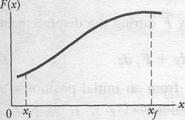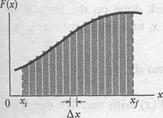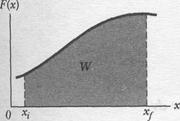
CATEGORIES:
BiologyChemistryConstructionCultureEcologyEconomyElectronicsFinanceGeographyHistoryInformaticsLawMathematicsMechanicsMedicineOtherPedagogyPhilosophyPhysicsPolicyPsychologySociologySportTourism
Work Done by a General Variable force
One-Dimensional Analysis
Let us return to the situation of Fig. 7-2 but now consider the force to be directed along the  axis and the force magnitude to vary with position
axis and the force magnitude to vary with position  . Thus, as the bead (particle) moves, the magnitude of the force doing work on it changes. Only the magnitude of this variable force changes, not its direction, and the magnitude at any position does not change with time.
. Thus, as the bead (particle) moves, the magnitude of the force doing work on it changes. Only the magnitude of this variable force changes, not its direction, and the magnitude at any position does not change with time.

|
Figure l-\2a shows a plot of such a one-dimensional variable force. We want an expression for the work done on the particle by this force as the particle moves from an initial point  , to a final point
, to a final point  . However, we cannot use Eq. 7-7 because it applies only for a constant force
. However, we cannot use Eq. 7-7 because it applies only for a constant force  . Here, again, we shall use calculus. We divide the area under the curve of Fig. 7-12a into a number of narrow strips of
. Here, again, we shall use calculus. We divide the area under the curve of Fig. 7-12a into a number of narrow strips of

|
width  (Fig. 1-I2b). We choose
(Fig. 1-I2b). We choose  small enough to permit us to take the force
small enough to permit us to take the force  as being reasonably constant over that interval. We let
as being reasonably constant over that interval. We let  be the average value of
be the average value of  within the
within the  -th interval. Then in Fig. 7-12b,
-th interval. Then in Fig. 7-12b,  is the height of the
is the height of the  -th strip.
-th strip.
With  considered constant, the increment (small amount) of work
considered constant, the increment (small amount) of work  ,-done by the force in the
,-done by the force in the  -th interval is now approximately given by Eq. 7-7 and is
-th interval is now approximately given by Eq. 7-7 and is
 (7-29)
(7-29)
In Fig. 7-12b,  , is then equal to the area of the
, is then equal to the area of the  -th rectangular, shaded strip.
-th rectangular, shaded strip.
To approximate the total work  done by the force as the particle moves from
done by the force as the particle moves from  to
to  , we add the areas of all the strips between
, we add the areas of all the strips between  and
and  in Fig. 7-12b:
in Fig. 7-12b:
 (7-30)
(7-30)
Equation 7-30 is an approximation because the broken "skyline" formed by the tops of the rectangular strips in Fig. 1-I2b only approximates the actual curve of  .
.

|
We can make the approximation better by reducing the strip width Ал and using more strips, as in Fig. 7-12c. In the limit, we let the strip width approach zero; the number of strips then becomes infinitely large and we have, as an exact result,
 (7-31)
(7-31)

|
This limit is exactly what we mean by the integral of the function F(x) between the limits  , and
, and  . Thus, Eq. 7-31 becomes
. Thus, Eq. 7-31 becomes
 (7-32)
(7-32)
If we know the function  , we can substitute it into Eq. 7-32, introduce the proper limits of integration, carry out the integration, and thus find the work.
, we can substitute it into Eq. 7-32, introduce the proper limits of integration, carry out the integration, and thus find the work.
Three-Dimensional Analysis
Consider now a particle that is acted on by a three-dimensional force
 (7-33
(7-33
in which the components  ,
,  , and
, and  can depend on the position of the particle that is, they can be functions of that position. However, we make three simplifications:
can depend on the position of the particle that is, they can be functions of that position. However, we make three simplifications:  may depend on
may depend on  but not on
but not on  or
or  ,
,  may depend on
may depend on  but not on
but not on  or
or  , and
, and  may depend on
may depend on  but not on
but not on  or
or  . Now let the particle move through an incremental displacement
. Now let the particle move through an incremental displacement
 (7-34)
(7-34)
The increment of work  done on the particle by
done on the particle by  during the displacement
during the displacement  is, by Eq. 7-8,
is, by Eq. 7-8,
 (7-35)
(7-35)
The work  done by
done by  while the particle moves from an initial position
while the particle moves from an initial position  with coordinates (
with coordinates (  ,
,  ,
,  ) to a final position
) to a final position  with coordinates (
with coordinates (  ,
,  ,
,  ) is then
) is then
 (7-36)
(7-36)
If  has only an
has only an  component, then the
component, then the  and
and  terms in Eq. 7-36 are zero and the equation reduces to Eq. 7-32.
terms in Eq. 7-36 are zero and the equation reduces to Eq. 7-32.
Date: 2015-01-12; view: 1730
| <== previous page | | | next page ==> |
| Work Done by a Gravitational force | | | Work-Kinetic Energy Theorem with a Variable Force |